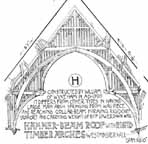
The "Hammer-beam Roof" is, as stated, considered to be a natural evolution of the triangular framing adopted at the foot of the trussed rafter roof, and consists generally of hammer-beam, struts, collars and curved braces. The hammer-beam is merely the lengthening and thickening of the "sole-piece" at the foot of the trussed rafter, the principal rafter being strutted, and the weight of llic roof carried lower down the wall by means of a curved brace tenoned into the hammer-beam and wall-piece. Being thus strengthened, it forms a truss which, repeated at intervals of 10 feet or more, supports the intermediate rafters of the bay.
It has been supposed by some that the hammer-beam arose from the cutting away of the tie-beam in the centre when a curved brace is used beneath the tie-beam. It is improbable, however, that this was the origin, and there is little more resemblance between a hammer-beam roof and a tie-beam roof than consists in their both being double framed, i.e., both having principals or trusses placed at regular intervals, as opposed to the trussed rafter type, which has no principal. Moreover, the tie- beam was used in all types of roof, even in conjunction with the hammer-beam itself, as at Outwell, where the intermediate principals are supplied with hammer-beams ; this is a late example, and was probably constructed after the hammer-beam type had attained perfection. Hammer-beams were not con- structed until the end of the fourteenth century, and were not in general use until the fifteenth century. Westminster Hall is the earliest recorded example, A.D. 1399.

[Westminster Hall. Click on thumbnail for larger image.]
There are many varieties of this form of roof: — (a) Those with hammer-beams, struts, collars and curved braces, as Little Welnetham Church, Suffolk, (b) Those in which the collar-beam is omitted and curved braces carried to the ridge, the apex being framed into a wedge-shaped strut, as at Trunch Church, Norfolk (See D in illustration above). (c) Those with collar-beams and no struts but curved braces, in which a shorter hammer- beam is used, as at Capel S. Mary, Suffolk, (d) Those with no collars and no struts, curved braces only being used from ridge to hammer-beam, as at Palgmve Church, Suffolk. The arch-braced roof is the outcome of this latter form. (e) Those with a main arched rib springing from wall-piece and reaching to a collar, forming a rigid chief support, as at Westminster and Eltham.
Double hammer-beam roofs have two ranges of hanirncr- beams, as at S. Margaret, Ipswich, and Middle Temple Hall (see E in illustration above), the object of the second range being to further stiffen the principals and convey the weight on to the first range and thence to the wall. They usually occur when the pitch is natter, but the effect is more complicated and less pleasing. These are the main divisions, but there are various minor modifications of the type. [pp. 291, 293; illus. p. 292]
Open Timber Roofs of the Middle Ages
References
Fletcher, Banister, and Banister F. Fletcher. A History of Architecture on the Comparative Method for the Student, Craftsman, and Amateur. 5th ed. London: B. T. Batsford, 1905.
Last modified 1 September 2007